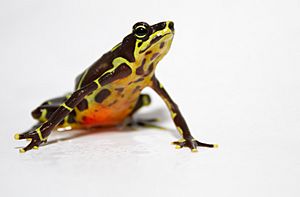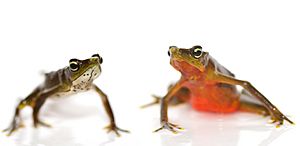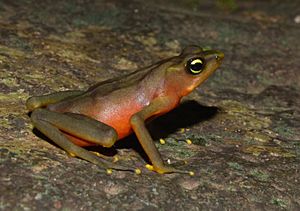Limosa harlequin frog facts for kids
Quick facts for kids Limosa harlequin frog |
|
|---|---|
 |
|
| Atelopus limosus female | |
| Conservation status | |
| Scientific classification |
The limosa harlequin frog (scientific name: Atelopus limosus) is a special kind of toad. It's known as the sapo limoso in Spanish. This frog is in danger of disappearing forever. It lives only in Panama, which means it is endemic there. You can find these frogs near streams and rivers in warm, wet forests, especially around the Chagres River area in central Panama.
Contents
About the Limosa Harlequin Frog
The limosa harlequin frog comes in two main color types. One type lives in lower areas and is brown. It has a yellow nose and yellow fingertips. The other type lives in higher, upland areas. This one is green with black V-shaped marks on its back.
Differences Between Males and Females
Male and female frogs of both color types look different. This is called being sexually dimorphic. Males are usually smaller than females. They have white bellies with small black spots. Females often have red or orange bellies.
What Do They Eat?
Scientists don't know much about what these frogs eat in the wild. But they think it's like what other Atelopus frogs eat. This usually includes small insects like beetles, ants, flies, and tiny mites. When these frogs are cared for by humans, they happily eat large fruit flies, small mealworms, and tiny crickets.
Saving the Limosa Harlequin Frog
The limosa harlequin frog faces two big threats. One is a serious frog disease called chytridiomycosis. The other is habitat loss, which means their natural homes are being destroyed. Because of these problems, the number of these frogs has been dropping very quickly.
The Chytrid Fungus Threat
The chytrid fungus has caused many frog species to disappear. About 75% of all known frog species living above 1000 meters have vanished. In lower areas, 58% of species have declined, and 38% have completely disappeared. This fungus seems to hit frogs in higher places harder.
Rescue Efforts in Panama
People were very worried about this special Panamanian frog. So, the Panama Amphibian Rescue and Conservation Project decided to help. They made the limosa harlequin frog a top priority. Their goal was to bring some frogs into captivity. This creates a "safety colony" to make sure the species doesn't die out.
When the rescue team went to Cerro Brewster, one of the last known places for these frogs, they found many were already sick with the chytrid fungus. Luckily, their program to breed these frogs in captivity has been successful. This gives hope for the future of the limosa harlequin frog.
See also
 In Spanish: Sapo limoso para niños
In Spanish: Sapo limoso para niños




